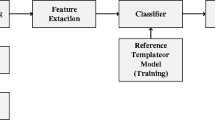Abstract
With cardiovascular disease as the number one killer of modern era, Electrocardiogram (ECG) is collected, stored and transmitted in greater frequency than ever before. However, in reality, ECG is rarely transmitted and stored in a secured manner. Recent research shows that eavesdropper can reveal the identity and cardiovascular condition from an intercepted ECG. Therefore, ECG data must be anonymized before transmission over the network and also stored as such in medical repositories. To achieve this, first of all, this paper presents a new ECG feature detection mechanism, which was compared against existing cross correlation (CC) based template matching algorithms. Two types of CC methods were used for comparison. Compared to the CC based approaches, which had 40% and 53% misclassification rates, the proposed detection algorithm did not perform any single misclassification. Secondly, a new ECG obfuscation method was designed and implemented on 15 subjects using added noises corresponding to each of the ECG features. This obfuscated ECG can be freely distributed over the internet without the necessity of encryption, since the original features needed to identify personal information of the patient remain concealed. Only authorized personnel possessing a secret key will be able to reconstruct the original ECG from the obfuscated ECG. Distribution of the key is extremely efficient and fast due to small size (only 0.04–0.09% of the original ECG file). Moreover, if the obfuscated ECG reaches to the wrong hand (hacker), it would appear as regular ECG without encryption. Therefore, traditional decryption techniques including powerful brute force attack are useless against this obfuscation.













Similar content being viewed by others
References
Access Economics Pty Limited, The shifting burden of cardiovascular disease in Australia, A report of Heart foundation, 2005 [Online]. Accessed at www.heartfoundation.com.au/media/nhfa shifting_burden_cvd_0505.pdf.
Sufi, F., Fang, Q., Mahmoud, S. S., and Cosic, I., A Mobile Phone Based Intelligent Telemonitoring Platform. In Proceedings of 3rd IEEE-EMBS ISSS-MDBS 2006, Boston, MA, USA, pp. 101–104, September, 2006.
Sufi, F., Fang, Q., and Cosic, I., ECG R-R Peak Detection on Mobile Phones. In Proceedings of 29th Annual International Conference of the IEEE EMBC, Lyon, France, pp. 3697–3700, August, 2007.
Sufi, F., Mobile phone programming with Java 2 Micro Edition. In Proceedings of the 2007 International Workshop on Mobile Computing Technologies for Pervasive Healthcare, Phillip Island, Melbourne, Australia, pp. 64–80, ISBN: 978-0-646-48230-9, December, 2007.
Eren, A., Subasi, A., and Coskun, O., A Decision Support System for Telemedicine through the Mobile Telecommunications Platform. J. Med. Syst. 32(1):31–35, 2008.
Health Insurance Portability Accountability Act of 1996 (HIPAA), Centers for Medicare and Medicaid Services (1996) [Online]. Accessed at http://www.cms.hhs.gov/hipaageninfo
Y. B., Capitan, K. E., Krause, J. S., and Streeper, M. M., Challenges associated with privacy in Health Care Industry: implementation of HIPAA and the security rules. J. Med. Syst. 30(1):57–64, 2006.
Springhouse, ECG Interpretation made incredibly easy, 2nd edition. Springhouse, Pennsylvania, 2001.
Bartolo, A., Clymer, B. D., Bugess, R. C., Turnbull, J. P., Golish, J. A., and Perry, M. C., An arrhythmia detector and heart rate estimator for overnight polysomnography studies. IEEE Trans. Biomed. Eng. 48(5):513–521, 2001.
Chan, A. D. C., Hamdy, M. M., Badre, A., and Badee, V., Wavelet distance measure for person identification using electrocardiograms. IEEE Trans. Instrum. Meas. 57(2):248–253, 2008.
Biel, L., Petersson, O., Philipson, L., and Wide, P., ECG analysis: a new approach in human identification. IEEE Trans. Instrum. Meas. 50(3):808–812, 2001.
Miaou, S.-G., Chen, S.-T., and Lin, C.-L., An integration design of compression and encryption for biomedical signals. J. Med. Biol. Eng. 22(4):183–192, 2002.
Lin, C. F., and Chung, C. S., A Chaos Base Visual Encryption Mechanism in ECG Medical Signal. IFMBE Proceedings on World congress on Medical Physics and Biomedical Engineering 2006. 14(4):2366–2369, 2007.
Last, T., Nugent, C. D., and Owens, F. J., Multi-component based cross correlation beat detection in electrocardiogram analysis. BioMed. Eng. OnLine. 3262004 doi:10.1186/1475-925X-3-26. Accessed at http://www.biomedical-engineering-online.com/content/3/1/26.
Ifeachor, E. C., and Jervis, B. W., Digital signal processing: a practical approach wokingham. Addison-Wesley, England, 1993.
Abboud, S., and Sadeh, D., The use of cross-correlation function for the alignment of ECG waveforms and rejection of extrasystoles. Comput. Biomed. Res. 17:258–266, 1984.
Govrin, O., Sadeh, S., Akselrod, S., and Abboud, S., Cross-correlation techniques for arrhythmia detection using PR and PP intervals. Comput. Biomed. Res. 18:37–45, 1985.
Kartalopoulos, S. V., A primer on cryptography in communications. IEEE Commun. Mag. 44(4):146–151, 2006.
Zigel, Y., Cohen, A., and Katz, A., The Weighted Diagnostic Distortion (WDD) measure for ECG signal compression. IEEE Trans. Biomed. Eng. 47(11):1422–1430, 2000.
Lee, W.-B., and Lee, C.-D., A cryptographic key management solution for HIPAA privacy/security regulations. IEEE Trans. Inf. Technol. Biomed. 12(1):146–151, 2008.
MsCharry, P. E., Clifford, G. D., Tarassenko, L., and Smith, L. A., A dynamical model for generating synthetic electrocardiogram signals. IEEE Trans. Biomed. Eng. 50(3):289–294, 2003.
Sandhu, R. S., Coyne, E. J., Feinstein, H. L., and Youman, C. E., Role-Based Access Control Models. IEEE Comput. 29(2):38–47, 1996.
Sufi, F., Mahmoud, S. S. and Khalil, I., A New ECG Obfuscation Method: A Joint Feature Extraction and Corruption Approach. In Proceedings of 5th International Conference on Information Technology and Application in Biomedicine, Shenzhen, China, 2008.
Sufi, F., Mahmoud, S. S. and Khalil, I., A Wavelet based secured ECG distribution technique for patient centric approach. In 5th International Workshop on Wearable and Implantable Body Sensor Networks, BSN & ISSS-MDBS 2008, Hong Kong, China, 2008.
Acknowledgment
The project was supported and funded by ECR Grant, an Australian Government Postgraduate Award and a Victorian Government ICT Postgraduate Award.
Author information
Authors and Affiliations
Corresponding author
Rights and permissions
About this article
Cite this article
Sufi, F., Khalil, I. A New Feature Detection Mechanism and Its Application in Secured ECG Transmission with Noise Masking. J Med Syst 33, 121–132 (2009). https://doi.org/10.1007/s10916-008-9172-6
Received:
Accepted:
Published:
Issue Date:
DOI: https://doi.org/10.1007/s10916-008-9172-6




